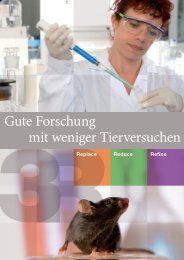You also want an ePaper? Increase the reach of your titles
YUMPU automatically turns print PDFs into web optimized ePapers that Google loves.
approval by ECVAM, the European Center<br />
for Validation of Alternative Methods.<br />
Experimental Design<br />
The project that originally was submitted<br />
to the European Commission (EC) was<br />
budgeted for € 18.7 million. The request<br />
by the EC to reduce this budget to €14.7<br />
million forced the Consortium to chose<br />
between ‘developing novel tests but using<br />
existing markers’ and ‘subjecting existing<br />
tests to extensive -omics analysis’.<br />
Considering the ultimate deliverables of<br />
the project, the Sens-it-iv choice was to<br />
select the second possibility (-omics) for<br />
the sake of mechanistic understanding<br />
(Figure 1).<br />
During the course of the project, emerging<br />
knowledge was invested in an effort to<br />
acquire access to the novel tests that were<br />
cut out of the budget. This was made<br />
possible by the Consortium Agreement<br />
making Sens-it-iv an intellectual property<br />
rights (IPR)-free project as far as test<br />
development is concerned.<br />
This investment was supported by<br />
partners from industry and academia,<br />
and resulted in additional national and<br />
international funding allowing the original<br />
objectives related to the development of<br />
novel tests to be pursued as well (€ 18.7<br />
million). It has to be stressed that the<br />
novel tests coming into the project this<br />
way are not the property of Sens-it-iv and<br />
therefore do not fall under the Consortium<br />
Agreement vis-à-vis IPR. The owners of the<br />
tests made the tests available for further<br />
development and refinement (WP8), and<br />
marker identification (WP2). Examples<br />
of such novel tests include the dendritic<br />
cell (DC) migration test, the alveolarendothelial<br />
lung model and the bronchial<br />
lung model.<br />
An additional budget (€500,000) was<br />
assigned by the Dutch funding agency<br />
ZonMW to run a pre-validation study on<br />
a selected test approach and to transfer<br />
lung EC-based tests to the Cultex system<br />
(allowing for aerosol/gas exposure of<br />
cell cultures). These activities will extend<br />
beyond the Sens-it-iv project (31 March<br />
2012).<br />
Project Structure<br />
In order to make it possible to manage<br />
such a large and complex project properly,<br />
the Sens-it-iv project was split in 3<br />
modules, each with a specific duration and<br />
each grouping specific research activities<br />
covered by dedicated work packages<br />
(WPs).<br />
As compared to the original structure,<br />
three important changes were suggested<br />
and accepted by the General Assembly in<br />
October 2007 and 2008 (Figure 2).<br />
Training for Pre-Validation (Months 24-38)<br />
This training was introduced in order to<br />
familiarise the partners with the procedures<br />
of pre-validation before tests were selected<br />
for evaluation and refinement (Technology<br />
Module). Three very simple dendritic cell<br />
(DC)-based assays that were selected.<br />
The result of this bridging activity was<br />
an understanding for the requirements<br />
PROGRESS REPORTS FROM EU-FUNDED PROJECTS<br />
Progress Report 2011 & AXLR8-2 Workshop Report<br />
159




